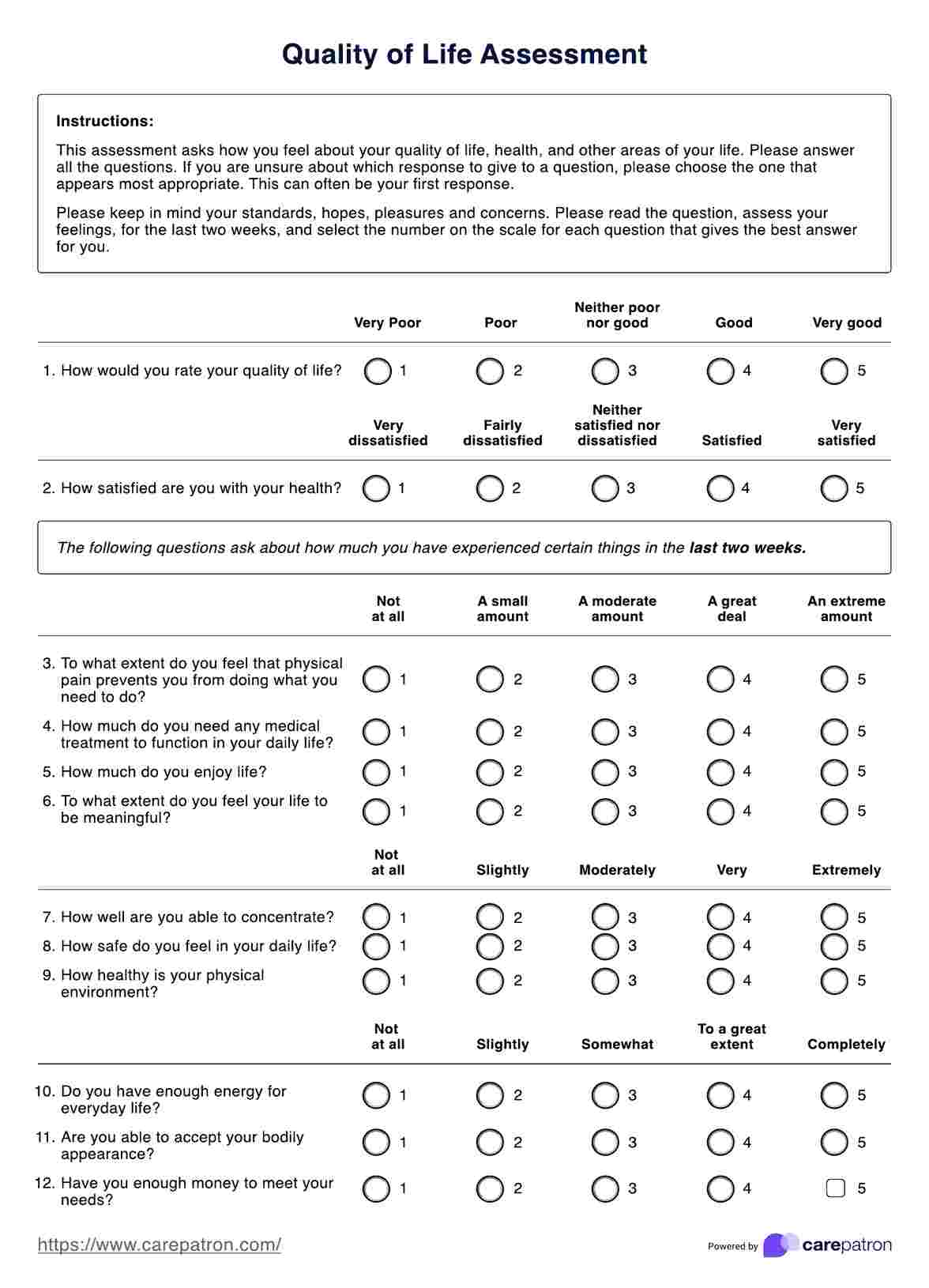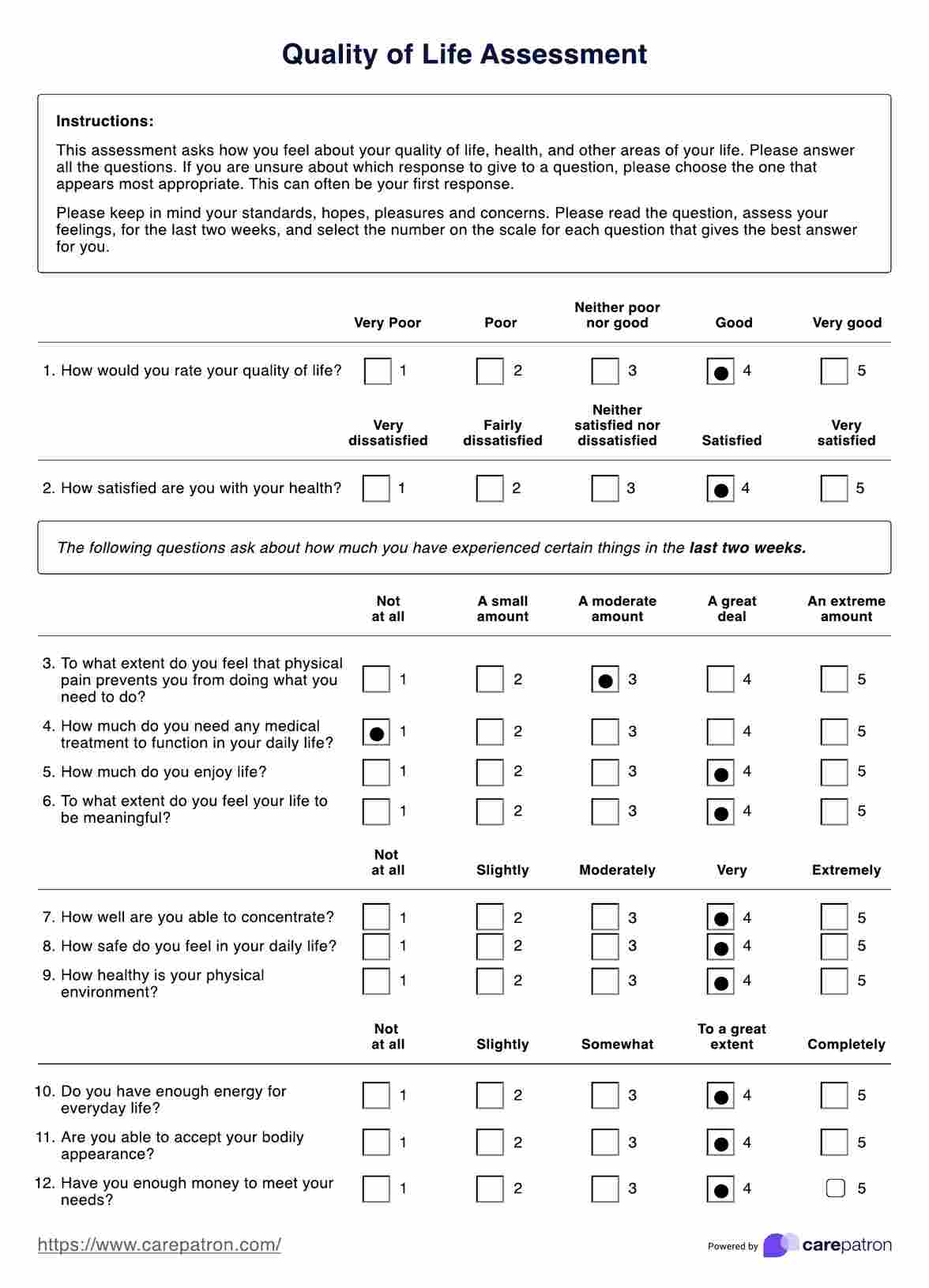Quality of Life Assessment
Empower patients & improve outcomes! Learn how Quality of Life (QoL) assessments provide valuable insights & benefit patients. Download our free template now.


What does "quality of life" mean?
Quality of life (QoL) is a crucial concept in patient care. It refers to an individual's overall well-being, value health, and satisfaction across various life domains, encompassing physical, mental, emotional, and social factors contributing to a patient's fulfillment and happiness (Teoli & Bharwadj, 2022).
QoL assessment goes beyond disease management. While the absence of illness is essential, QoL emphasizes measuring the quality of positive elements that enhance daily life. Understanding a patient's QoL helps you tailor treatment plans that address the disease and its impact on their overall well-being.
Health-related quality of life (HRQoL) is a specific aspect of QoL that focuses on how health status affects an individual's well-being. This includes a person's physical health and functioning, health-related symptoms, emotional well-being, and the ability to perform daily activities (ADLs).
Remembering that QoL is subjective and varies across cultures and value systems is essential. What constitutes a "good" QoL for one patient may differ from another based on their beliefs, priorities, and experiences. The World Health Organization (2000) emphasizes this by defining QoL as an individual's perception of their life within their specific context. This highlights the importance of considering cultural factors, culture, value systems, and individual goals when assessing QoL.
By understanding patient QoL, you can develop patient-centered care plans, monitor treatment effectiveness, and improve patient communication. You can also use this care plan template to organize and document patient care strategies effectively. It aids in tracking progress and adjusting interventions as needed, ensuring continuous and effective treatment.
Why is it essential to maintain a good quality of life?
A good quality of life isn't just about feeling good; it's about thriving across multiple dimensions. Here's how it benefits your patients:
- Improved physical health: Studies show a link between good QoL and better health outcomes, including lower chronic disease risk, increased longevity, and higher energy levels.
- Enhanced mental well-being: Good QoL reduces stress, anxiety, and depression, leading to greater emotional resilience and psychological well-being.
- Boosted productivity: Individuals with a good QoL often experience higher productivity and efficiency in all aspects of life, leading to more tremendous success and satisfaction.
- Stronger relationships: Good QoL fosters positive interactions with others, leading to stronger social connections and a supportive network.
- Greater life satisfaction: A good QoL enhances overall life satisfaction and fulfillment, allowing individuals to find meaning and purpose in their experiences.
- Increased resilience: Good QoL builds resilience in the face of challenges, enabling your patients to cope effectively with difficulties and bounce back from setbacks.
By understanding QoL, you can empower your patients to actively manage their mental health conditions and achieve a more fulfilling life.
Quality of Life Assessment Template
Quality of Life Assessment Example
What is a Quality of Life Assessment?
A Quality of Life Assessment (QoL Assessment) isn't just another medical test. It's a comprehensive evaluation designed to understand how a patient's health affects their well-being. It goes beyond the physical aspects of health and delves into various life domains, including mental, emotional, and social factors, and how health-quality life outcomes are achieved.
These assessments typically involve standardized questionnaires that patients answer directly. The questionnaires address various topics, from physical functioning and daily activities to emotional well-being and social interactions. By gathering this patient-reported information, healthcare professionals gain valuable insights into how a patient's health and any treatments they're receiving impact their daily lives.
How does our Quality of Life Assessment template work?
The Quality of Life Assessment template adapted by Carepatron from WHO's WHOQOL-BREF is a tool designed to understand patients' perceptions of their quality health care services and life-related to their health and other life domains. Here’s how healthcare professionals can use this template effectively:
Step 1: Introduction and context setting
Introduce the Quality of Life Assessment to the patient, explaining that it gauges their perceptions of quality of life and perceived health within the last two weeks. Encourage honest and instinctual responses, asking them to reflect on their standards, hopes, and concerns as they complete the questionnaire.
Step 2: Completing the rating sections
Guide the patient through the assessment, starting with general questions about life quality and health. They should rate these aspects of life instruments on scales ranging from very poor to very good or very dissatisfied to very satisfied, as appropriate.
Step 3: Detailed experience evaluation
Ask the patient to evaluate their life research the extent to which they've experienced various states such as pain, medical dependency, and enjoyment of life, along with functional and environmental aspects. They will assess their concentration, safety, physical environment, energy, body image, financial sufficiency, and leisure opportunities.
Step 4: Satisfaction and frequency assessments
The patient should then assess their satisfaction across different life domains, including sleep, daily life scale, activities, work, self-esteem, relationships, living conditions, health services, and transport. Finally, they will indicate the frequency of negative feelings they've experienced recently.
Step 5: Review and data utilization
Once completed, review the responses to ensure all sections are filled out accurately. Use the insights from this WHO-adapted Carepatron template to inform the patient's care plan, addressing any identified concerns to enhance their overall quality of life and health management.
Benefits of taking this assessment
Quality of Life Assessments offer numerous benefits for individuals, healthcare professionals, and researchers alike:
Improved disease management for patients & providers
Quality of Life Assessments provide valuable insights into how chronic illnesses impact a patient's well-being. This information allows healthcare professionals to tailor treatment plans and interventions to address each patient's specific needs. This targeted approach can improve disease management and overall health outcomes.
Empowering patients and enhancing care
Quality of Life Assessments involve patients in their healthcare journey. By providing input on their experiences, patients contribute to developing personalized care plans that align with their values and goals. This collaborative approach fosters open communication with healthcare providers, ultimately leading to a more satisfying patient experience.
Informing research & improving healthcare delivery
Quality of Life Assessmentss are valuable tools for researchers studying healthcare interventions and policies. The data gathered from these assessments helps scientists understand the real-world impact of different approaches on patient well-being. This knowledge can inform future healthcare practices and improve the quality of healthcare delivered.
5 key strategies for improving quality of life
Empowering patients to take charge of their well-being extends beyond symptom management. Quality of life (QoL) is crucial to patient care, influencing treatment adherence and overall health outcomes. Here are five key strategies you can recommend to help patients improve their QoL:
- Prioritize physical health habits: Encourage regular exercise, balanced nutrition, and adequate sleep. Exercise boosts energy levels, reduces stress, and improves mood. Guide patients towards healthy eating habits and emphasize the importance of quality sleep for optimal well-being.
- Foster strong social connections: Social support significantly impacts QoL. Encourage patients to cultivate strong relationships with family and friends. Consider recommending social support groups or community activities that align with their interests.
- Promote stress management techniques: Equip patients with tools like mindfulness meditation, deep breathing exercises, or relaxation practices. These techniques can significantly enhance their mental well-being and overall QoL. Consider collaborating with mental health professionals to address more complex stress-related issues.
- Encourage personal growth activities: Learning and development contribute to a fulfilling life. Motivate patients to pursue hobbies, develop new skills, or set meaningful goals. These activities provide a sense of purpose, accomplishment, and self-confidence, all contributing to improved QoL.
- Maintain work-life integration: Help patients achieve a healthy balance between work and personal life. Encourage setting boundaries, prioritizing self-care, and scheduling time for relaxation and activities they enjoy. A balanced lifestyle prevents burnout and fosters better overall well-being.
By incorporating these strategies into your patient care approach, you can empower individuals to optimize their QoL and achieve their health goals actively.
References
Teoli, D., & Bhardwaj, A. (2022). Quality of life. PubMed; StatPearls Publishing. https://www.ncbi.nlm.nih.gov/books/NBK536962/#:~:text=Definition%2FIntroduction
World Health Organization. (2000). WHOQOL-BREF| The World Health Organization. https://www.who.int/tools/whoqol/whoqol-bref
Commonly asked questions
QoL assessments provide valuable insights into the impact of chronic health conditions on a patient's daily life. This information allows for more personalized treatment plans, improved patient communication, and better monitoring of treatment effectiveness.
These assessments typically use standardized questionnaires that address physical functioning, mental well-being, social interactions, and emotional aspects of health. Patients report on their experiences, offering a comprehensive picture of the medical outcomes of their QoL.
Many resources are available to help healthcare professionals integrate QoL assessments. Tools like Carepatron's sample template can guide you in implementing these assessments and utilizing them to improve patient care and outcomes.
























-template.jpg)














































































